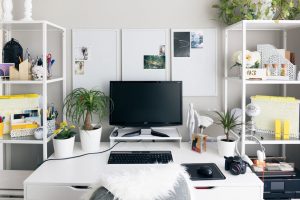What started as a temporary remedy in response to the pandemic has become a permanent reality for many of us: the home office. If you’re still working at your dining room table on a dining room chair or kitchen stool – stop. You’re not doing yourself any favors. The wrong desk height and the wrong chair can create aches and pains throughout your body – and drain your brain power.
 I’ve seen much longer hours in the workday at home than in the office, and so have many of my clients. That might be due in part to the nature of the work; and it might be partially because we want to excel. The right desk height and chair are important for your neck and shoulders. If you are working slightly hunched over, which many of us have a tendency to do when we are concentrating, you’re most likely rubbing your neck or shoulders at some point in the day.
I’ve seen much longer hours in the workday at home than in the office, and so have many of my clients. That might be due in part to the nature of the work; and it might be partially because we want to excel. The right desk height and chair are important for your neck and shoulders. If you are working slightly hunched over, which many of us have a tendency to do when we are concentrating, you’re most likely rubbing your neck or shoulders at some point in the day.
Carve out your space. If possible, create it in a separate area, ideally with a door if you have kids that are at home, or if your children will be home schooled.
You need the privacy for meetings – whether on the phone or on ZOOM – so find a way to block it off from the rest of the house. Room divider screens are pretty handy if you do not have a separate room with a door.
Sit-stand desks allow you to stand to stretch your legs, or customize the height that is perfect for you, and they give your body a break from sitting for long periods of time. I personally like the cushioned office chairs with lumbar support because most of my work is writing, and I do sit for long periods of time.
 Next, stock up on the supplies you need. Staplers, tape dispensers, paper clips, a ruler, scissors, calendar planner, sticky notes, file folders – whatever you need to mimic your workplace office. This is important for overall productivity. Ever hear that saying, “because of a horse, the kingdom was lost?” Don’t let yourself not complete a task because you do not have the right supplies at hand.
Next, stock up on the supplies you need. Staplers, tape dispensers, paper clips, a ruler, scissors, calendar planner, sticky notes, file folders – whatever you need to mimic your workplace office. This is important for overall productivity. Ever hear that saying, “because of a horse, the kingdom was lost?” Don’t let yourself not complete a task because you do not have the right supplies at hand.
Make it yours. Add framed pictures, a desk light, a plant, an inspirational phrase – anything that makes it your space. If you need pretty, add the colors you like or a favorite item. Organize printers and scanners so they are accessible without being obtrusive. If you have a calendar planner or a whiteboard at work, get one for the home office..
 Finally, stay organized. I like accordion folders for varying files, and I like labels that indicate what the file is for. I keep them in a bookcase behind my desk so I can get to what I need easily. I also keep my last supply order sheet handy so I can check off what I need for the next go-round. Don’t forget about lighting. My space gets a lot of natural sunlight, but I do have a desk lamp that will be used more in the winter months.
Finally, stay organized. I like accordion folders for varying files, and I like labels that indicate what the file is for. I keep them in a bookcase behind my desk so I can get to what I need easily. I also keep my last supply order sheet handy so I can check off what I need for the next go-round. Don’t forget about lighting. My space gets a lot of natural sunlight, but I do have a desk lamp that will be used more in the winter months.
Finally, remember to give your brain a break. Get up at least once an hour, stretch, walk outside, or block off some time to do some light exercise. Get your mind off of work for at least a lunch hour’s length so you can get back to work fully recharged.
Until next time, be well.
Maureen H. Cronin
